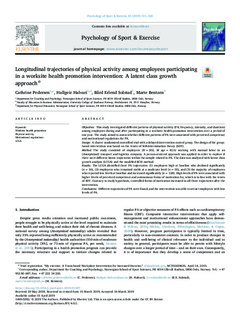| dc.contributor.author | Pedersen, Cathrine | |
| dc.contributor.author | Halvari, Halgeir | |
| dc.contributor.author | Solstad, Bård Erlend | |
| dc.contributor.author | Bentzen, Marte | |
| dc.date.accessioned | 2020-01-15T12:41:21Z | |
| dc.date.available | 2020-01-15T12:41:21Z | |
| dc.date.created | 2019-04-05T11:34:15Z | |
| dc.date.issued | 2019 | |
| dc.identifier.citation | Psychology of Sport And Exercise. 2019, 43, 311-320. | nb_NO |
| dc.identifier.issn | 1469-0292 | |
| dc.identifier.uri | http://hdl.handle.net/11250/2636429 | |
| dc.description | This is an open access article under the CC BY license | nb_NO |
| dc.description.abstract | Objectives: This study investigated different patterns of physical activity (PA; frequency, intensity, and duration) among employees during and after participating in a worksite health-promotion intervention over a period of one year. The study aimed to assess whether different patterns of PA were associated with perceived competence and motivational regulations for PA. Design: A cluster randomized controlled trial with a delayed-intervention control group. The design of the group-based intervention was based on the tenets of Self-determination theory (SDT). Method: The study consisted of employees (N = 202, M age = 42.5) working with manual labor in an (Anonymized) transport and logistics company. A person-centered approach was applied in order to explore if there were different latent trajectories within the sample related to PA. The data was analyzed with latent class growth analysis (LCGA) and the modified BCH method. Results: The LCGA identified three PA trajectories: (1) employees high at baseline who declined significantly (n = 16), (2) employees who remained stable at a moderate level (n = 55), and (3) the majority of employees who reported low levels at baseline and increased significantly (n = 128). High levels of PA were associated with higher levels of perceived competence and autonomous forms of motivation for, which is in line with the tenets of SDT. Contrary to study hypothesis, controlled forms of motivation increased in all three trajectories after the intervention. Conclusions: Different trajectories of PA were found, and the intervention was able to attract employees with low levels of PA. | nb_NO |
| dc.language.iso | eng | nb_NO |
| dc.rights | Navngivelse 4.0 Internasjonal | * |
| dc.rights.uri | http://creativecommons.org/licenses/by/4.0/deed.no | * |
| dc.title | Longitudinal trajectories of physical activity among employees participating in a worksite health promotion intervention: A latent class growth approach | nb_NO |
| dc.type | Journal article | nb_NO |
| dc.type | Peer reviewed | nb_NO |
| dc.description.version | publishedVersion | nb_NO |
| dc.rights.holder | © 2019 The Authors | nb_NO |
| dc.source.pagenumber | 311-320 | nb_NO |
| dc.source.volume | 43 | nb_NO |
| dc.source.journal | Psychology of Sport And Exercise | nb_NO |
| dc.identifier.doi | 10.1016/j.psychsport.2019.03.007 | |
| dc.identifier.cristin | 1690399 | |
| cristin.unitcode | 222,57,3,0 | |
| cristin.unitname | Institutt for økonomi, markedsføring og jus | |
| cristin.ispublished | true | |
| cristin.fulltext | original | |
| cristin.qualitycode | 1 | |

